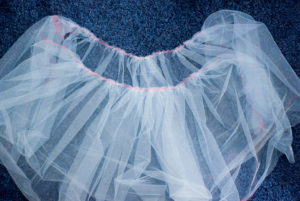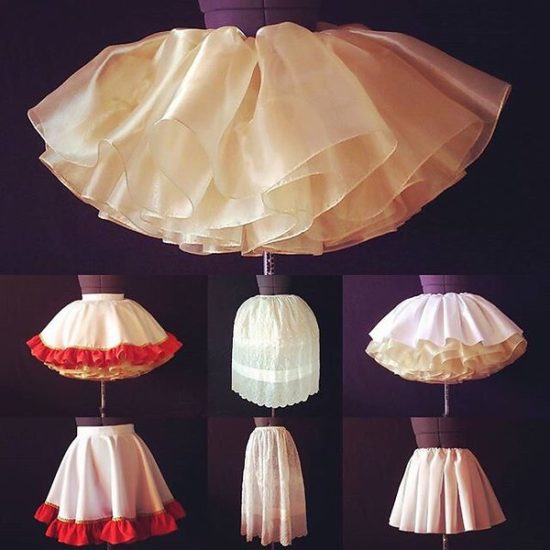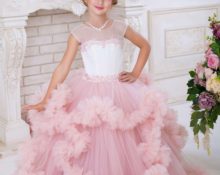For many years, a petticoat was a mandatory attribute of a woman's wardrobe. It was used to add volume to ballgowns, then in the 50s and 60s. For several decades, the petticoat went out of everyday use. But fashion is cyclical and today its use can again be relevant not only at weddings and children's parties, but also on weekdays.

How to sew a petticoat with your own hands - what material should you choose?
Petticoats can be varied in length, style, layering and stiffness.

For wedding dresses, a rigid cone with rings is often used. This will allow you to sew a petticoat that is light and holds its shape well.

For the hard version, tulle is used. It can vary in hardness, but the most rigid tulle is most suitable. Often one layer of tulle is enough to add volume. True, his main drawback is his causticity. He scratches his legs and sometimes tears his tights. Therefore, craftswomen usually add a layer of soft fabric between the body and the petticoat.
Soft tulle is not very suitable for a petticoat.It will require several layers, which increases fabric consumption. But from such tulle you can sew a popular tutu skirt and wear it as a petticoat or separately.
Choosing a petticoat style
The simplest style - this is a rectangle of fabric pulled at the waist with a belt or elastic band. Tatyanka skirts are sewn in a similar way. If the tulle is stiff and the resulting volume is sufficient, the petticoat is ready.

For greater volume, several layers are joined together. To prevent the design from being bulky or heavy, the petticoat is made in a single layer and with rings. This is suitable for evening or ball gowns.
Another style of petticoat – A-line with flounces and frills. It adds volume smoothly, suitable for children's dresses. For production you will need soft tulle in several layers. It is this kind of petticoat that will be discussed in the master class below.
Master class on how to sew a full petticoat for a dress
To create a pattern, 2 measurements are enough:
- semi-circumference of the hips;
- petticoat length.
Next they calculate Rwaist and Rlength And draw out a “half-sun” pattern.
Rwaist= (half hip circumference + 10 cm for freedom of fit)/π
Rlength= Rwaist + petticoat length.
For a knee-length skirt, 3 frills are enough. They should be located at an equal distance from each other. To do this, step 10–12 cm away from the waist line from above and mark the first line of the frill. The remaining length of the skirt is divided by 3 and the distance between the frills is obtained. If the resulting number is not a multiple of 3, the height of the indentation from the waist can be adjusted.
After this, calculate the length of fabric that will be required for each frill. Here you need 2 measurements: Rwaist, the length of the indent and the length of the remaining skirt.

Formulas for calculating each frill starting from the top:
1: (Rwaist + indent length)* π
2: (Rwaist + indent length+ 1/3 of the remaining length)* π
3: (Rwaist + indent length+ 2/3 of the remaining length)* π
As a result, all the frills will reach the edge of the skirt, but the top one will be the longest.
Each assembly is tightened to the length of the arc. And the contraction coefficient can be taken arbitrarily. For the upper skirt it is better to take a coefficient of 3, and for the lower skirt a higher coefficient, for example, 5, is acceptable.
If the tulle is hard, then the frill can be single-layer; for softer tulle it is better to use a two-layer frill.
Next, all that remains is to assemble the skirt:
- Each frill must be pulled to the length of the arc. If the frill is single-layer, then the stitching is done on a machine, indenting 1 cm from the top. In a two-layer frill, the stitching is laid exactly in the middle along the entire frill.
- Then the frills pull the skirt down to length.
- On the pattern of a half-sun skirt, mark the ruffle lines with soap. The skirt will have one seam - the back one. 1 cm from its edge is left for stitching.
- First, pin the top frill and sew it on with a machine.
- Also available with middle and bottom frills.
- When all the frills are sewn on, they are ironed with a warm iron so that they do not puff up.
- Now the skirt is sewn along the back seam.
- An elastic band equal to the length of the skirt waistband is cut out of a smooth fabric. Belt width: 2 elastic widths + 2 cm.
- The belt is pinned to the waistband of the skirt, then the elastic is sewn into a ring and placed in the belt.
- After this, the belt can be closed and stitched.
- If the tulle is very stiff, you can cut a lining from a rectangle of fabric before sewing on the belt. It is pinned to the skirt, back to back, and a belt is sewn on.

Sewing a petticoat is not that difficult. A simple one will require 1 hour of free time. But you can immediately use it in your own wardrobe. A petticoat is suitable not only for festive events.It will be relevant in light spring weather or hot summer, and will also add playfulness to the image.


 0
0





